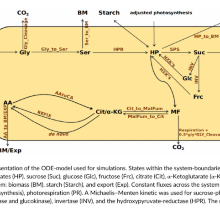Plants exposed to elevated atmospheric CO2 concentrations show an increased pho-
tosynthetic activity. However, after prolonged exposure, the activity declines. This
acclimation to elevated CO2 is accompanied by a rise in the carbon-to-nitrogen ratio
of the biomass. Hence, increased sugar accumulation and sequential downregulation
of photosynthetic genes, as well as nitrogen depletion and reduced protein content,
have been hypothesized as the cause of low photosynthetic performance. However,
the reason for reduced nitrogen content in plants at high CO2 is unclear. Here, we
show that reduced photorespiration at increased CO2-to-O2 ratio leads to reduced
de novo assimilation of nitrate, thus shifting the C/N balance. Metabolic modeling of
acclimated and non-acclimated plants revealed the photorespiratory pathway to
function as a sink for already assimilated nitrogen during the light period, providing
carbon skeletons for de novo assimilation. At high CO2, low photorespiratory activity
resulted in diminished nitrogen assimilation and eventually resulted in reduced car-
bon assimilation. For the hpr1-1 mutant, defective in reduction of hydroxy-pyruvate,
metabolic simulations show that turnover of photorespiratory metabolites is
expanded into the night. Comparison of simulations for hpr1-1 with those for the
wild type allowed investigating the effect of a perturbed photorespiration on
N-assimilation.


